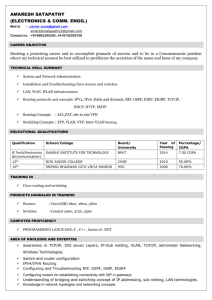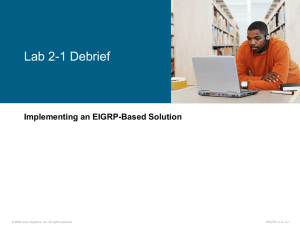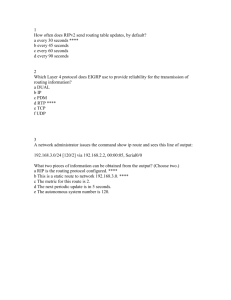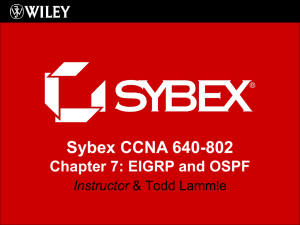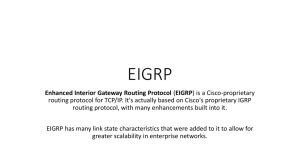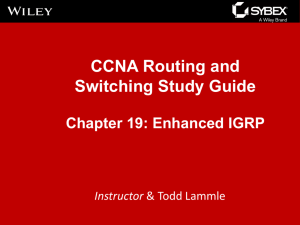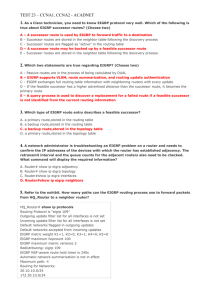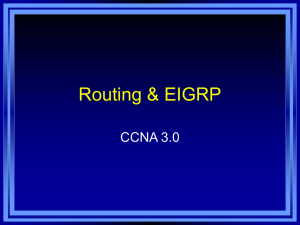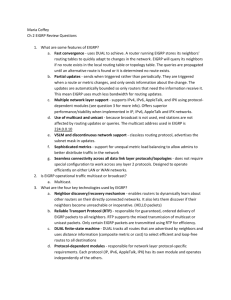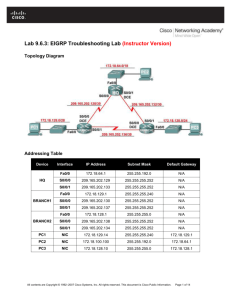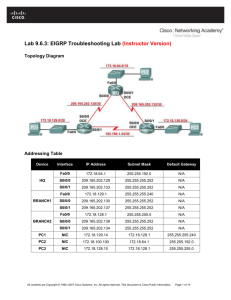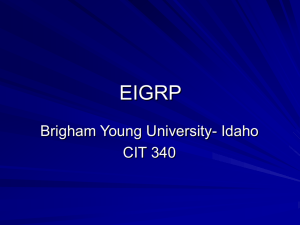Abstract - Chennaisunday.com
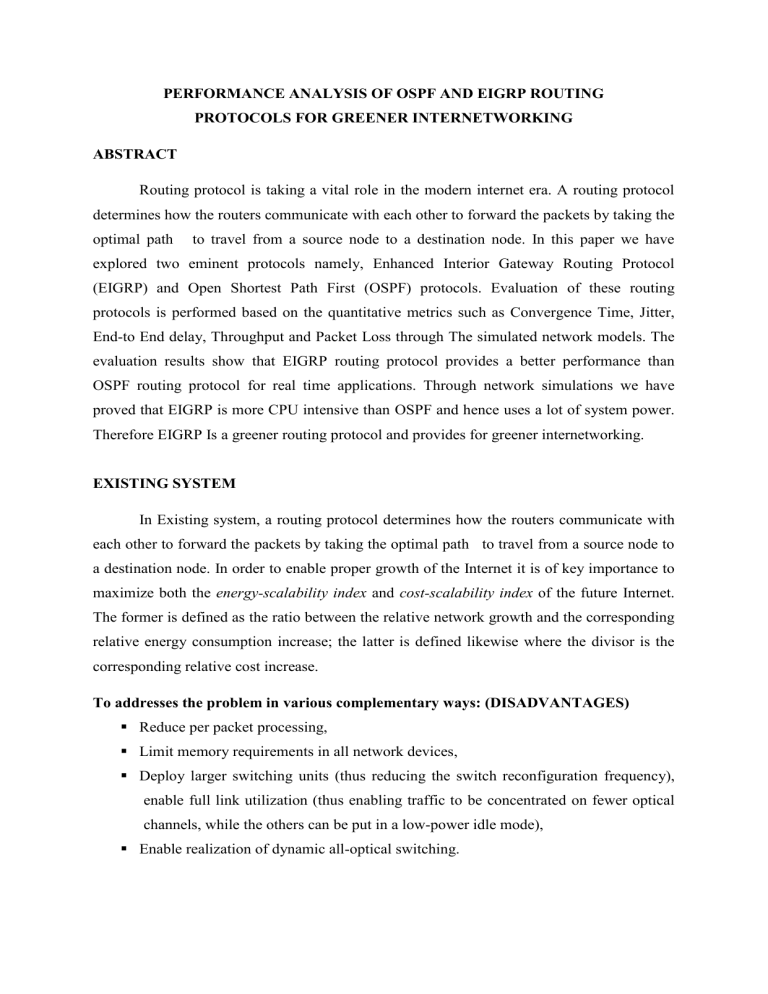
PERFORMANCE ANALYSIS OF OSPF AND EIGRP ROUTING
PROTOCOLS FOR GREENER INTERNETWORKING
ABSTRACT
Routing protocol is taking a vital role in the modern internet era. A routing protocol determines how the routers communicate with each other to forward the packets by taking the optimal path to travel from a source node to a destination node. In this paper we have explored two eminent protocols namely, Enhanced Interior Gateway Routing Protocol
(EIGRP) and Open Shortest Path First (OSPF) protocols. Evaluation of these routing protocols is performed based on the quantitative metrics such as Convergence Time, Jitter,
End-to End delay, Throughput and Packet Loss through The simulated network models. The evaluation results show that EIGRP routing protocol provides a better performance than
OSPF routing protocol for real time applications. Through network simulations we have proved that EIGRP is more CPU intensive than OSPF and hence uses a lot of system power.
Therefore EIGRP Is a greener routing protocol and provides for greener internetworking.
EXISTING SYSTEM
In Existing system, a routing protocol determines how the routers communicate with each other to forward the packets by taking the optimal path to travel from a source node to a destination node. In order to enable proper growth of the Internet it is of key importance to maximize both the energy-scalability index and cost-scalability index of the future Internet.
The former is defined as the ratio between the relative network growth and the corresponding relative energy consumption increase; the latter is defined likewise where the divisor is the corresponding relative cost increase.
To addresses the problem in various complementary ways: (DISADVANTAGES)
Reduce per packet processing,
Limit memory requirements in all network devices,
Deploy larger switching units (thus reducing the switch reconfiguration frequency), enable full link utilization (thus enabling traffic to be concentrated on fewer optical channels, while the others can be put in a low-power idle mode),
Enable realization of dynamic all-optical switching.
PROPOSED SYSTEM
In Proposed System, using EIGRP with optimizations to minimize both the routing instability incurred after topology changes, as well as the use of bandwidth and processing power in the router. Routers that support EIGRP will automatically redistribute route information to IGRP neighbours by converting the 32 bit EIGRP metric to the 24 bit
IGRP metric.
Using OSPF, a host that obtains a change to a routing table or detects a change in the network immediately multicasts the information to all other hosts in the network so that all will have the same routing table information.
ADVANTAGE
A system where it sends only the updates needed at a given time; this is accomplished through neighbour discovery and maintenance
A way of determining which paths a router has learned are loop-free
A process to clear bad routes from the topology tables of all routers on the network
A process for querying neighbours to find paths to lost destinations
Enhanced Interior Gateway Routing Protocol – EIGRP
Open Shortest Path First (OSPF)
MODULES
EIGRP Operations a.
Building neighbour relationships b.
Choosing routes
OSPF Operations a.
Finding neighbours b.
Creating Adjacency c.
Sharing routing information
MODULES DESCRIPTION
EIGRP OPERATIONS
In this module, EIGRP is a distance vector protocol because it learns about other routing routes by rumours from the neighbouring routers. a.
Building neighbour relationship
In this module,
1.
The first router generates a hello with its configuration information
2.
If the configuration information (Autonomous system numbers and K values) matches then the second router responds with an update message with its local topology table information (not its routing table as done by the distance vector protocols)
3.
The first router responds with an ACK message acknowledging the receipt of the second’s Update. The first router then sends its topology table to second router via an update message. The second router responds with an ACK message as for transferring of routing updates are concerned
There are 3 types of messages involved. They are o UPDATE- Contains a routing update o QUERY- Asks a neighbouring router to validate routing information o REPLY- Responds to a query message. b.
Choosing routes
In this module, EIGRP has the following metrics bandwidth, reliability, delay, load and MTU. However only fixed metrics such as bandwidth and delay are activated.
EIGRP maintains something such as successor route and a feasible successor route in the local topology table. Successor route is the route via which the packets are forwarded and has the best metric. Feasible successor route is the route with which the router will forward packets once the successor route goes down or has the second best metric. This is the advantage of
EIGRP, once a route goes down it doesn’t have to send hello packets to find out another alternative route. It just brings on the feasible successor route.
OSPF OPERATIONS a.
Finding neighbours
In this module, a router finds its neighbours by sharing link state advertisements which exist in different types .OSPF generates hello messages every 10 seconds, When a neighbour is discovered and an adjacency is formed with the neighbour then the router expects to see hello messages every 10 from the neighbour .
If a neighbour’s message is not seen within 40 seconds (dead interval time). The hello packet contains information like the area number, hello and dead timer intervals, OSPF password if it is configured. b.
Creating Adjacency
In this module, In OSPF, adjacency is created if the information from the hello packets of one router match with the information present in the configuration file of the proposed router. c.
Sharing routing information
In this module, OSPF routers use link state advertisements to communicate with each other. One type of LSA is hello which is used to form neighbour relationships and as a keep alive function. Link state advertisements are sent to the disseminates this to everyone else at the multicast address.
HARDWARE REQUIREMENTS
System
Hard Disk
Monitor
Mouse
Ram
: Pentium IV 2.4 GHz.
: 80 GB.
: 15 VGA Colour.
: Logitech.
: 512 MB.
SOFTWARE REQUIREMENTS
Operating system :
Front End :
Coding Language :
Database :
Windows 8 (32-Bit)
Visual Studio 2008
C#.NET
SQL Server 2008



![Internetwork & TCP/IP [Opens in New Window]](http://s3.studylib.net/store/data/008490208_1-eaf10231908f97f1b47b18fe3c507663-300x300.png)




